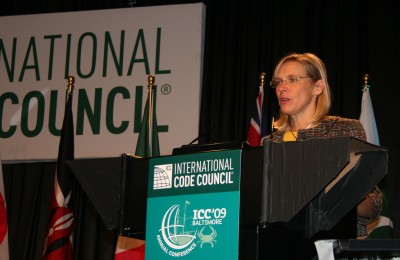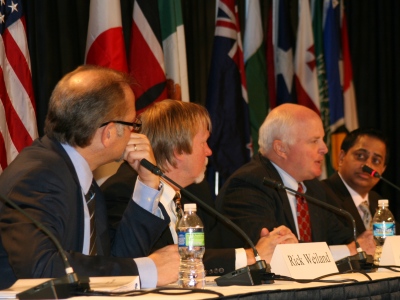Code Development, Adoption and Compliance Are Key to Achieving Energy Efficiency
 Noting that the U.S. Department of Energy (DOE) submitted more than 75 proposals for the Code Development Hearings in Baltimore, Catherine Zoi (right), Assistant Secretary for the DOE's Office of Energy Efficiency and Renewable Energy (EERE), told Annual Conference attendees that energy efficiency and conservation are a central initiative of the Obama Administration. Noting that the U.S. Department of Energy (DOE) submitted more than 75 proposals for the Code Development Hearings in Baltimore, Catherine Zoi (right), Assistant Secretary for the DOE's Office of Energy Efficiency and Renewable Energy (EERE), told Annual Conference attendees that energy efficiency and conservation are a central initiative of the Obama Administration.
"Clean energy is central because there is an intersection of three things that make it profoundly important," Zoi explained. "The first is national security: energy independence; the second is climate protection: climate change, stopping global warming; and the third is job creation.
"We've got an economy, as we all know, that's in malaise," Zoi continued. "The next industrial revolution is going to come on the back of a clean energy revolution that is going to create millions of jobs for Americans."
Zoi commended attendees for the work that has already been done by code officials to reduce the carbon footprint of buildings. "Forty percent of our primary energy is consumed in buildings, and 72 percent of our electricity, so let me get back to commending you for the work that you've done—the 2009 IECC (International Energy Conservation Code) getting a 10–15 percent improvement in our residential building stock," she said. "Let me also commend you for actively engaging in the 30-percent challenge for 2012, which I understand became within a hare's-breath of being part of the 2009 code. Thirty-percent challenge for 2012, that's very, very exciting. Let me now put it to a bit of a challenge. Let me challenge you to go forth (and) let's push for that 30 percent together."
Zoi acknowledged efforts to develop energy efficiency codes that date back to the 1970s, and said such innovation is the fabric of code officials. "It seems to me that technical progress is in America's DNA," she said. Zoi then recalled an idea while she was an employee with the Environmental Protection Agency to develop energy-saving devices for office equipment and personal computers. During a meeting with Apple representatives, she discovered the idea had already been discussed by technical staff members. "They said, 'We've been wanting to do this for years,'" Zoi explained. "And I said, 'Well, if it's technically possible, then why didn't you?' And they said, 'The Marketing Department wouldn't let us.' So we created a marketing reason for the engineers to do what engineers do best, and that is innovate."
"Consider that we now have air bags in our cars and that's normal, and we have anti-lock brakes in our cars and it's normal, well, 10-15 years ago there was somebody probably saying in some CFO's office, 'Well, we can't afford to do this,'" Zoi continued. "But it wasn't the engineers, it wasn't the technicians—they always know that we can do more, we can do it better and we can do it for costing less. We innovate."
Zoi said the challenges for achieving energy efficiency include the lack of energy code adoptions across the country. "I was actually surprised to discover that only a few states have adopted the 2009 energy code so far, and still there are about a dozen states that are working off of 1998 or no energy code at all," she said. "There are myriad reasons for this, but a model code that gets outlined by all of you smart folks, but doesn't find a home in the states and localities, makes all of this good and fruitful discussion for naught. All of this good work and then we can't find a home for it. I hope that we can agree to say no to orphan building codes that don't find a home and don't get adopted."
Another challenge, Zoi said, is addressing low code compliance of existing buildings. "The Alliance to Save Energy suggests that, even for places where the energy code has been adopted, only 50 percent of the buildings meet the energy provisions of the code," she explained. "We're going to fall well short of our energy saving objectives if we don't have this get better."
"All 50 governors sent letters of assurance to the Secretary of Energy saying they will comply with Section 410 of the Recovery Act (American Recovery and Reinvestment Act), and that requires compliance with the most recent version of the model code at a 90-percent compliance level," Zoi continued. "Well, if we're going to get this sort of compliance, some things have to change."
Zoi said the DOE is committed to supporting the development, adoption and compliance of energy codes across the country. In doing so, she said input from code officials and the entire ICC membership will be valuable as new retrofitting programs are implemented across the country. "We are very much looking forward to partnering with you, figuring out how to do this sensibly, to do it so the consumers save money, and so the people in the industry have more work and have great work."
 Code Council CEO Rick Weiland led a panel discussion during the Opening Session that updated attendees on the development of the new International Green Construction Code (IGCC). Participants included ICC Board of Directors member Ravi Shah, who is serving as chairman of the Sustainable Building Technology Committee (SBTC) that is developing the first draft of the code; Christopher Green of the American Institute of Architects, who also serves as vice chairman of the SBTC, and Ken Pierson of ASTM International. Code Council CEO Rick Weiland led a panel discussion during the Opening Session that updated attendees on the development of the new International Green Construction Code (IGCC). Participants included ICC Board of Directors member Ravi Shah, who is serving as chairman of the Sustainable Building Technology Committee (SBTC) that is developing the first draft of the code; Christopher Green of the American Institute of Architects, who also serves as vice chairman of the SBTC, and Ken Pierson of ASTM International.
"We're in the process of developing the first green code for high performance in commercial buildings," Weiland said. "The work that has preceded us has really set the stage for many of our jurisdictions who now feel that they really need a regulatory framework in the form of a code."
Shah said the SBTC committee members have adopted a slogan while undertaking the large task of developing the first draft of the IGCC. "We continuously ask ourselves these three questions: is this code or this language usable, is it adoptable, and is it enforceable?" he said. "I think the SBTC is committed to have the IGCC draft look and work like other I-Codes. In fact, we are dedicated to making this code integrate with the family of I-Codes. Once that code comes out, you won't be able to tell the difference."
|

